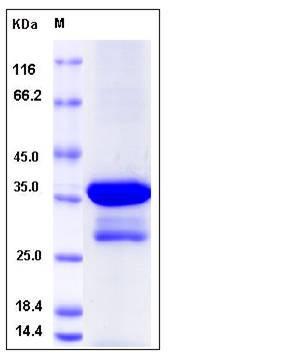Human DCX Protein (aa 45-150, GST Tag)
DBCN,DC,LISX,SCLH,XLIS
- 100ug (NPP3796) Please inquiry
| Catalog Number | P13498-H09E |
|---|---|
| Organism Species | Human |
| Host | E. coli |
| Synonyms | DBCN,DC,LISX,SCLH,XLIS |
| Molecular Weight | The recombinant human DCX (aa 45-150)/GST chimera consists of 340 amino acids and has a predicted molecular mass of 39.4 kDa. It migrates as an approxiamtely 36 KDa band in SDS-PAGE under reducing conditions. |
| predicted N | Met |
| SDS-PAGE |  |
| Purity | > 82 % as determined by SDS-PAGE |
| Protein Construction | A DNA sequence encoding the human DCX (O43602-2) N-terminal fragment (Ala 45-Val 150) was fused with the GST tag at the N-terminus. |
| Bio-activity | |
| Research Area | Neuroscience |Cell Type Marker in Neurodevelopment |Neuronal Cell Markers |Soma marker |
| Formulation | Lyophilized from sterile 20mM Tris, 1mM DTT, 10% glycerol, pH 7.5 1. Normally 5 % - 8 % trehalose and mannitol are added as protectants before lyophilization. Specific concentrations are included in the hardcopy of COA. |
| Background | DCX (doublecortin, N-GST chimera)contains 2 doublecortin domains and belongs to the doublecortin family. It is highly expressed in neuronal cells of fetal brain, but not expressed in other fetal tissues. In the adult, it is highly expressed in the brain frontal lobe, but very low expression in other regions of brain, and not detected in heart, placenta, lung, liver, skeletal muscles, kidney and pancreas. DCX is a microtubule-associated protein required for initial steps of neuronal dispersion and cortex lamination during cerebral cortex development. It may act by competing with the putative neuronal protein kinase DCAMKL1 in binding to a target protein. DCX may in that way participate in a signaling pathway that is crucial for neuronal interaction before and during migration, possibly as part of a calcium ion-dependent signal transduction pathway. It may be part with LIS-1 of a overlapping, but distinct, signaling pathways that promote neuronal migration. Defects in DCX are the cause of lissencephaly X-linked type 1 and subcortical band heterotopia X-linked. |
| Reference |
